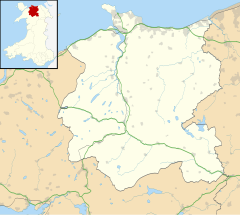Cerrigydrudion
| Cerrigydrudion | |
|---|---|
 Cerrigydrudion |
|
| Cerrigydrudion shown within Conwy | |
| Population | 740 (2011) |
| OS grid reference | SH952488 |
| Community |
|
| Principal area | |
| Ceremonial county | |
| Country | Wales |
| Sovereign state | United Kingdom |
| Post town | CORWEN |
| Postcode district | LL21 |
| Dialling code | 01490 |
| Police | North Wales |
| Fire | North Wales |
| Ambulance | Welsh |
| EU Parliament | Wales |
| UK Parliament | |
| Welsh Assembly | |
Cerrigydrudion, sometimes spelt Cerrig-y-drudion, is a village and community in Conwy, Wales. Until 1974 it was part of the historic county Denbighshire, when it became part of the newly formed county of Clwyd. When the county of Clwyd was abolished in 1996, the village was transferred to the new Conwy County Borough. The village formerly lay on the A5, but a short by-pass now takes the road along the south-western edge of the village. Prior to the by-pass being built, Cerrigydrudion was the highest village on the A5 between London and Holyhead.
Geographically the area is classed as moorland and less favourable grassland. It is on the outskirts of Mynydd Hiraethog. The oldest feature of the village is the parish church dedicated to Saint Mary Magdalene. It is believed to have existed in 440 AD. It is also mentioned in the 'Norwich Taxation' of 1254. The village is the largest in the area known as Uwchaled which also includes Llangwm, Pentrefoelas, Pentre-llyn-cymer, Dinmael, Glasfryn, Cefn Brith, Llanfihangel Glyn Myfyr and Cwm Penanner. Llangwm and Pentrefoelas are stand-alone parishes whilst the remainder fall within the parish of Cerrigydrudion. However, there are multiple Nonconformist chapels throughout the area of Uwchaled, located in many of the minor villages and hamlets.
The village was mentioned in the writings of several noted travellers including Edward Lhuyd and George Borrow. It attained a certain significance in the 18th century when Thomas Telford built the A5 turnpike Toll road between London and Holyhead. This would be the main route to Ireland. The road passed through the village. In the farmhouse of Ceirnioge Mawr, where the stagecoach and Mail coach horses were changed, there is a plaque marking the fact that Queen Victoria stopped there en route to Ireland.
...
Wikipedia

